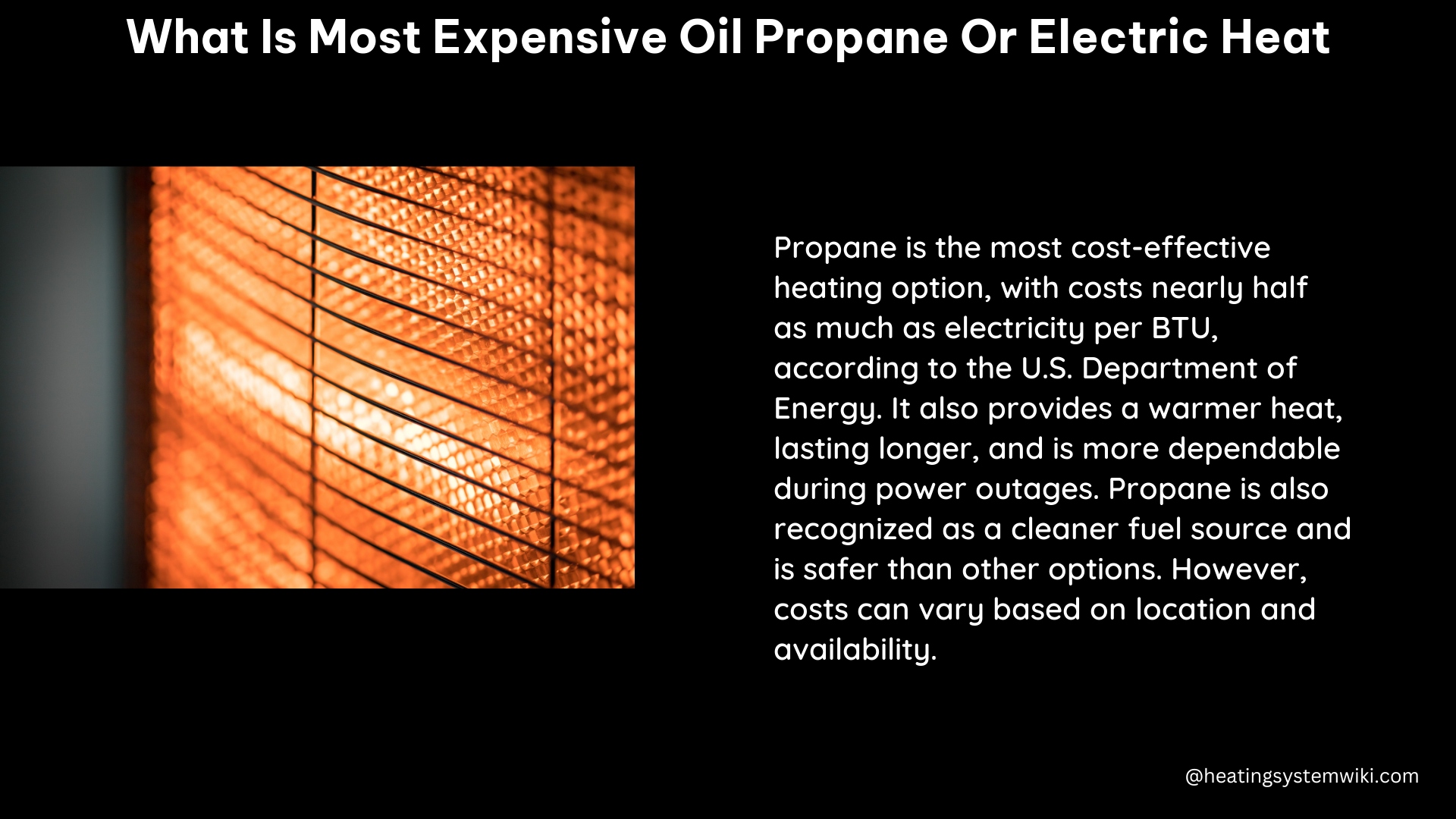When it comes to heating your home, the choice between oil, propane, and electric heat can have a significant impact on your energy costs. Determining the most expensive option among these three heating sources requires a deep dive into the technical specifications, energy prices, and efficiency factors. In this comprehensive guide, we’ll explore the intricacies of each heating method to help you make an informed decision.
Oil Heat: The Costliest Option
Oil heat is generally considered the most expensive heating option due to several factors:
-
Fuel Costs: The price of fuel oil has been on the rise in recent years, with the U.S. Energy Information Administration (EIA) reporting an average residential price of $3.66 per gallon as of January 2023. This cost can fluctuate based on global market conditions and regional supply and demand.
-
Maintenance Requirements: Oil-fired furnaces and boilers require annual maintenance, including a tune-up and cleaning, which can add around $100 to $300 per year to the overall operating costs.
-
Efficiency Levels: Older oil heating systems typically have lower efficiency ratings, ranging from 80% to 85%, compared to newer, high-efficiency models that can reach up to 95% efficiency. Lower efficiency means more fuel is required to generate the same amount of heat, leading to higher energy consumption and costs.
-
Environmental Impact: Oil heat is often considered less environmentally friendly than other heating options due to the emissions and potential for oil spills or leaks, which can result in additional cleanup and remediation costs.
Propane Heat: A Moderate Option

Propane heat is generally less expensive than electric heat, but the cost can vary depending on several factors:
-
Fuel Costs: The U.S. EIA reports that the average residential price of propane was $2.91 per gallon as of January 2023, which is significantly lower than the cost of fuel oil.
-
Efficiency Levels: Propane furnaces and boilers typically have efficiency ratings ranging from 80% to 95%, similar to modern oil heating systems. This means they can provide the same amount of heat while using less fuel.
-
Water Heating Costs: Propane water heaters can be one-third less expensive to operate and heat water twice as quickly as electric water heaters, according to the U.S. Department of Energy.
-
Regional Variations: The cost of propane can vary depending on your location, with some regions experiencing lower prices due to proximity to production or distribution hubs.
Electric Heat: The Pricier Alternative
Electric heat is generally considered the most expensive heating option, especially in regions with high electricity prices:
-
Electricity Costs: The U.S. EIA reports that the average residential electricity price was $0.14 per kilowatt-hour (kWh) as of January 2023. This cost can be significantly higher in certain regions, making electric heat a more expensive choice.
-
Efficiency Levels: Electric resistance heating, such as baseboard heaters or wall units, have an efficiency rating of 100%, meaning all the energy consumed is converted into heat. However, this high efficiency does not necessarily translate to lower operating costs due to the high electricity prices.
-
Climate Considerations: Electric heat pumps, which provide both heating and cooling, can be more cost-effective in milder climates, as they are more efficient at extracting heat from the outside air. In colder regions, however, the efficiency of heat pumps can decrease, leading to higher energy consumption and costs.
-
Whole-Home Heating: Heating an entire home with electric resistance heating can be more expensive than using a centralized heating system, such as a furnace or boiler, which can distribute heat more efficiently throughout the living space.
To determine the estimated cost of electric heat for your home, you can use the following formula:
- Decide if you live in a mild winter climate (1,000 BTUs/sq ft.) or a moderate winter climate (2,000 BTUs/sq ft).
- Multiply that number by the square footage of your home to get the total number of BTUs needed.
- Divide the BTU number by 3,412 to convert it to kilowatts/hour.
- Multiply the kilowatts/hour by the cost of kilowatts per hour in your area (you can usually find this on your energy bill or from a local government source).
- The resulting number will be a rough estimate of your monthly electric heating costs.
For propane heat, you can estimate the cost by:
- Determining the number of BTUs needed for your home (repeat steps 1 and 2 from the electric heat cost estimation).
- Contacting your local One Hour Heating & Air Conditioning or a propane supplier to get the current price per gallon in your area.
In conclusion, when it comes to the most expensive heating option among oil, propane, and electric heat, the answer is not straightforward and depends on various factors, including location, energy prices, and heating system efficiency. Oil heat is generally considered the most expensive, followed by electric resistance heating, while propane heat tends to be the more cost-effective option, especially in regions with lower propane prices.
References:
- Bogleheads Forum – Heating Cost: Propane vs. Electric
- This Old House – Propane vs. Oil Heat
- One Hour Heating & Air Conditioning – Electric vs. Propane Heat: Cost and Maintenance Comparison
- Petro – Propane vs. Electric Heat
- IRV2 Forums – Heating Cost: Propane vs. Electric
- U.S. Energy Information Administration – Residential Energy Prices
- U.S. Department of Energy – Propane Heating
